In recent years there has been an increase in the number of pests and diseases arriving from abroad, largely attributed to the rise in volume and diversity of plants and plant products (e.g. fruit and timber) being imported from an increasingly diverse range of sources. Changes in climate and subsequent phenological changes may also increase the risk of pests and diseases becoming established.
The pests and diseases described on this page are either not known to be present, or are of limited distribution, and some are under eradication in the UK.
Plants showing symptoms or signs of the pests and diseases below should be reported to the Animal and Plant Health Agency (APHA).
Find out about the latest pests of concern with the European Plant Protection Organisation Biosecurity Pest Alerts for 2019.
Diseases
| Chestnut blight |
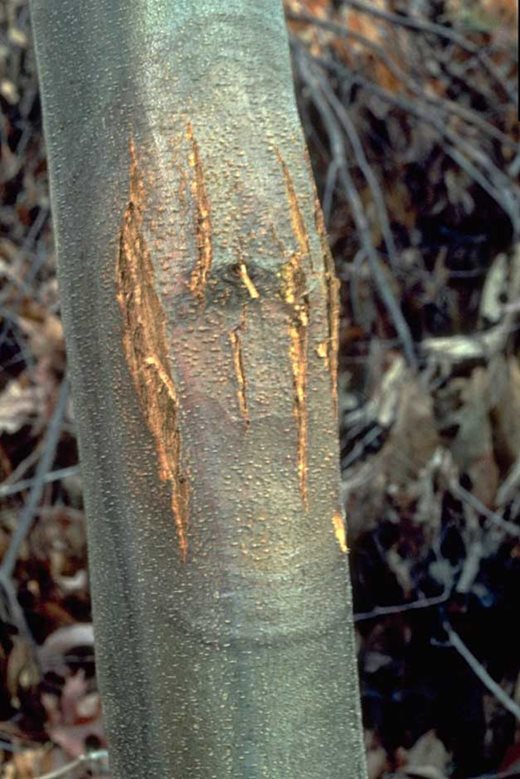 A fungal disease (Cryphonectria parasitica) that poses a significant threat to sweet chestnut in the UK. It has devastated American chestnut in Northern America and sweet chestnut in Europe. A fungal disease (Cryphonectria parasitica) that poses a significant threat to sweet chestnut in the UK. It has devastated American chestnut in Northern America and sweet chestnut in Europe.
Symptoms: Cankers swollen or sunken form on the trunk, on which masses of yellow-orange to red-brown pustules (fruiting bodies) form. Branches die back and eventually the tree may be killed.
Where present: Asia, Africa, North America, and Continental Europe. It was observed for the first time in the UK in 2011 in Warwickshire and East Sussex. More recently it has been observed at sites in Devon, Dorset, Kent and east London.
RHS advice on sweet chestnut blight
Forestry Commission information on sweet chestnut blight
Image courtesy of USDA Forest Service |
| Phytophthora |
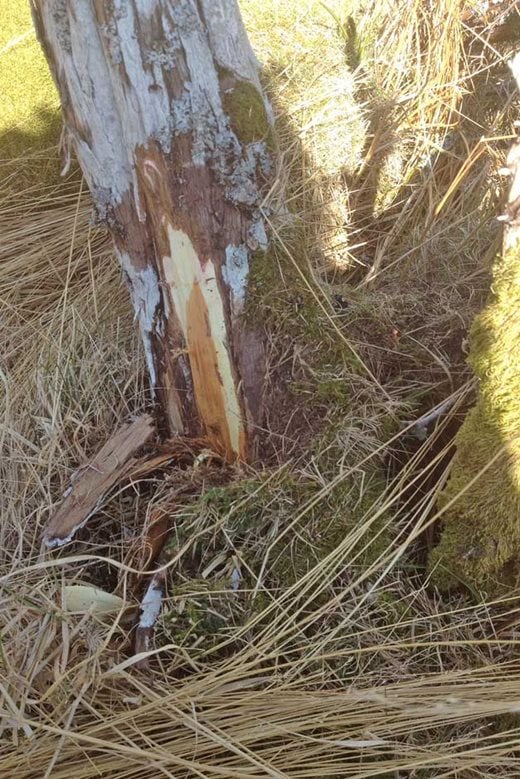 (Many species, but controlled species include Phytophthora ramorum, P. kernoviae and P. austrocedri) (Many species, but controlled species include Phytophthora ramorum, P. kernoviae and P. austrocedri)
Fungus-like pathogens that produce waterborne spores (zoospores) which are spread by water, in soil and on plants.
Symptoms: Browning and die-back of foliage. Lesions form under the bark causing brown/ black discolouration.
Where present: Some of the controlled species are present in the UK and becoming more widespread (e.g. P. ramorum); others are not present (e.g. P. pinifolia).
Forestry Commission: Phytophthora ramorum
Forestry Commission Phytophthora lateralis
Forestry Commission Phytophthora kernoviae |
| Rose rosette virus |
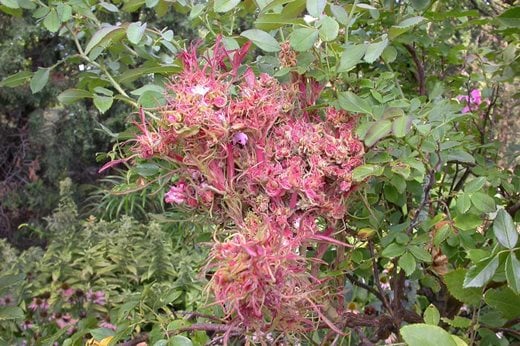 Rose rosette virus infects a wide range of cultivated and wild rose species, and is spread by the microscopic mite, Phyllocoptes fructiphilus. Rose rosette virus infects a wide range of cultivated and wild rose species, and is spread by the microscopic mite, Phyllocoptes fructiphilus.
Symptoms: Increased production of thorns and vegetative shoots, usually coloured red; distorted leaves with red pigmentation; stunting, and often death.
Where present: Canada, USA and India. Not present in the UK.
More information (from Missouri Botanical Garden).
Image courtesy of Missouri Botanical Garden
|
| Stem dieback of hazelnut |
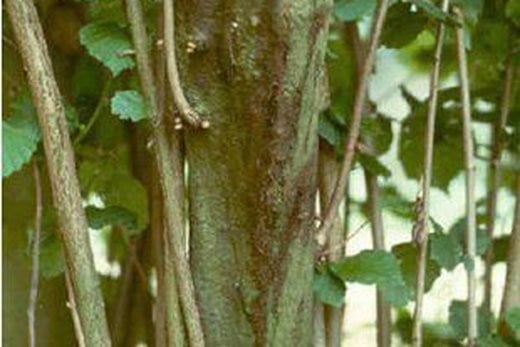 Stem dieback of hazelnut (also called Hazelnut bacterial canker) is a bacterial disease caused by Pseudomonas avellanae. The disease is present in parts of Europe but is not in the UK. Stem dieback of hazelnut (also called Hazelnut bacterial canker) is a bacterial disease caused by Pseudomonas avellanae. The disease is present in parts of Europe but is not in the UK.
Symptoms: The bacterium can enter a new host through scars in early autumn and symptoms become apparent in hosts in the following spring. Early signs of the disease are wilt and dieback of twigs. Oozing branch cankers can develop which may lead to branch dieback. The disease can be fatal to hazelnut trees within a couple of years of infection. The disease spreads from tree to tree by wind and rain. Spring frosts can exacerbate the disease by causing wounds from which the pathogen can enter.
Where present: Greece and Italy. The disease seems to be limited to areas with highly acidic soil. Areas of the UK with highly acidic soil may be at great risk if the disease were to arrive.
CABI factsheet
Image courtesy of Dr. Marco Scortichini
|
| Wilt of oak and plane |
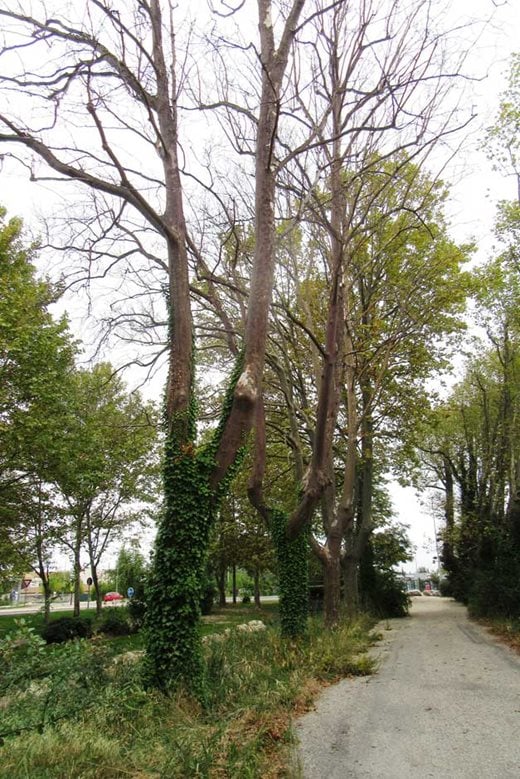 Vascular wilt diseases caused by two different species of the fungus Ceratocystis: (C. fagacearum and C. platani). Oak and plane are the two main hosts. Vascular wilt diseases caused by two different species of the fungus Ceratocystis: (C. fagacearum and C. platani). Oak and plane are the two main hosts.
Symptoms: Both cause wilting of the leaves and die-back of the crown. Staining occurs in the xylem of affected trees.
Where present: Oak wilt widespread in the USA, plane wilt present in mainland Europe. Neither present in the UK.
Forestry Commission information about oak wilt
Forestry Commission pest alert about plane wilt
Image courtesy of Maxime Guérin |
| Xylella fastidiosa |
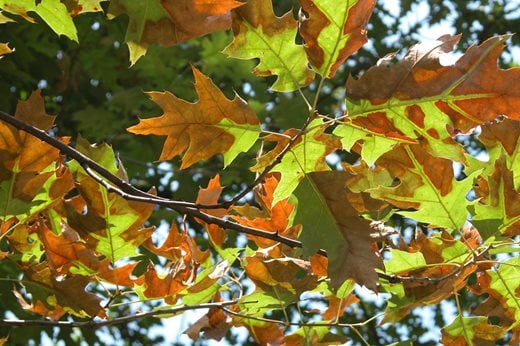 The bacterium Xylella fastidiosa is one of the biggest risks to the UK horticultural industry and wider landscape. It infects a wide range of plants including many species grown in gardens, such as cherry, hebe, lavender, oak and rosemary. The bacterium causes symptoms including leaf scorch, wilt, dieback and plant death. Unfortunately these symptoms are easily confused with stresses such as frost damage and drought, or other plant diseases. Xylella is spread between plants by insects such as froghoppers and leafhoppers which feed on infected plants. However, long-distance movement of the disease is most likely to occur through trade in infected plant material. The bacterium Xylella fastidiosa is one of the biggest risks to the UK horticultural industry and wider landscape. It infects a wide range of plants including many species grown in gardens, such as cherry, hebe, lavender, oak and rosemary. The bacterium causes symptoms including leaf scorch, wilt, dieback and plant death. Unfortunately these symptoms are easily confused with stresses such as frost damage and drought, or other plant diseases. Xylella is spread between plants by insects such as froghoppers and leafhoppers which feed on infected plants. However, long-distance movement of the disease is most likely to occur through trade in infected plant material.
Xylella is native to the Americas where it causes disease in many crops including citrus, coffee and grapevine. Until recently Xylella was absent from Europe but in 2013, Xylella was identified as the cause of death of olive trees in Italy. Since then it has been found in France and Germany (on oleander and polygala), on numerous ornamental plants (including cherry trees) in the Balearic Islands, and most recently in June 2017 it was confirmed in an almond orchard in Alicante, mainland Spain.
RHS Advice on Xylella fastidiosa
Defra guidance document on implications of Xylella fastidiosa for importers and professional users of plants
Reports of Xylella fastidiosa in Europe (the EPPO region)
Xylella fastidiosa host list
IPSN poster showing symptoms of Xylella infection
Image courtesy of Penn State Department of Plant Pathology and Environmental Microbiology Archives, Bugwood.org
|
| Zebra chip |
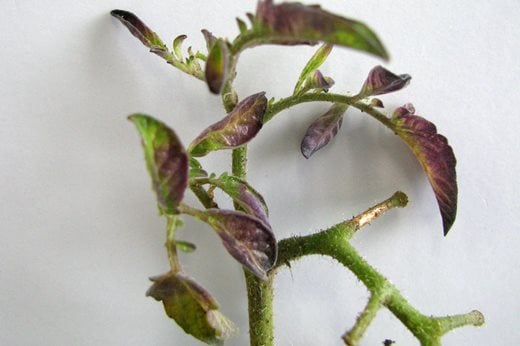 A bacterium (Candidatus liberibacter solanacearum) spread by psyllids (plant suckers). Five strains (haplotypes) occur: two affecting potatoes and related crops; three affecting carrots and celery. A bacterium (Candidatus liberibacter solanacearum) spread by psyllids (plant suckers). Five strains (haplotypes) occur: two affecting potatoes and related crops; three affecting carrots and celery.
Symptoms: Solanaceous plants (potatoes, tomatoes etc.) show stunting, chlorosis, leaf scorching and purpling of foliage. Fruits fail to set or are misshapen. Potato tubers display striped browning when cooked, hence the name zebra chip. Carrots become stunted, with discoloured, curling leaves.

Where present: North and Central America, New Zealand (on solanaceous crops) and Europe (on carrots and celery). Not present in the UK.
CABI invasive species datasheet
Images courtesy of Ministry for Primary Industries, New Zealand |
Pests
| Oriental chestnut gall wasp |
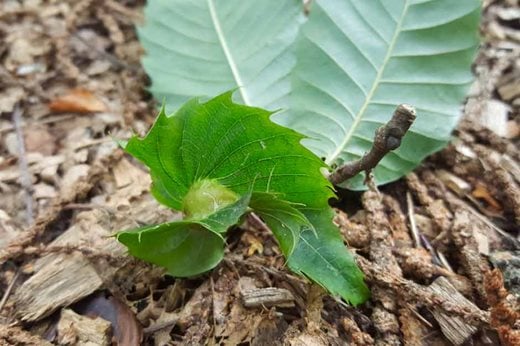 Oriental chestnut gall wasp (Dryocosmus kuriphilus) is a small insect (2.5-3mm) with a black body and orange-brown legs whose larvae feed within the buds of trees. Oriental chestnut gall wasp (Dryocosmus kuriphilus) is a small insect (2.5-3mm) with a black body and orange-brown legs whose larvae feed within the buds of trees.
Symptoms: Green, rose-coloured or red galls up to 4cm in diameter on the buds, leaves, and leaf stalks. Leaf distortion as a result of the growth of the galls. Leaves affected by the gall wasp can drop early, or remain on the tree throughout the winter
Where present: Originating from Asia, this species arrived in Europe in 2002 and was first recorded in the UK in 2015 - it is now fairly widespread throughout south east England.
RHS advice on oriental chestnut gall wasp
Forestry Commission information on oriental chestnut gall wasp
|
| Emerald ash borer |
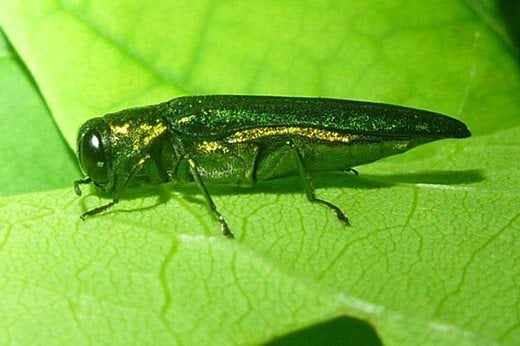 The emerald ash borer (EAB, Agrilus planipennis) is a pest of ash trees. It is native to Asia but has been introduced to other countries where it has been highly invasive causing the decline and death of ash trees. The beetle has spread westwards across the Eurasian landmass at a rate of 25 miles per year and is now threatening Europe. EAB is not in the UK, but we remain vigilant for accidental introduction. The introduction of this beetle could have devastating consequences to our ash trees, which have already declined due to ash dieback disease. The emerald ash borer (EAB, Agrilus planipennis) is a pest of ash trees. It is native to Asia but has been introduced to other countries where it has been highly invasive causing the decline and death of ash trees. The beetle has spread westwards across the Eurasian landmass at a rate of 25 miles per year and is now threatening Europe. EAB is not in the UK, but we remain vigilant for accidental introduction. The introduction of this beetle could have devastating consequences to our ash trees, which have already declined due to ash dieback disease.
Symptoms: An infestation of EAB on ash trees is usually fatal for the tree. Symptoms of infestation are dying branches and dieback of foliage typically from the top down. There may be longitudinal fissures in the bark caused by larval feeding, or D-shaped holes in the bark produced from the adults emerging. Peeling the bark back will reveal serpentine galleries, which are caused by the larvae feeding and burrowing through the heartwood. There may be increased woodpecker activity on the tree from their attempts to extract the beetles. The adults resemble several species of native and established Agrilus species, however these do not affect healthy ash trees.
Where present: China, Japan, Taiwan, Korea, Mongolia, Russia, North America.
Forest Research EAB information
Woodland Trust EAB information
|
| Japanese beetle |
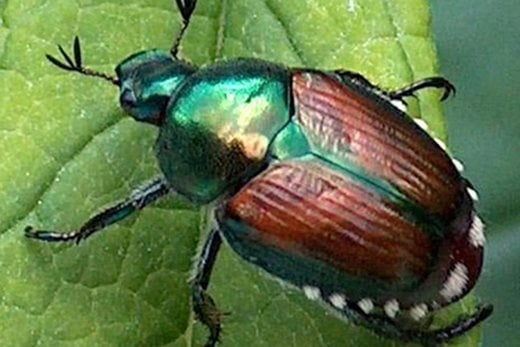 Popillia japonica is a chafer beetle, commonly known as the ‘Japanese beetle’. The beetle was first found in Europe in 2014, but has not yet been found in the UK. If introduced to the UK, it could have an impact on many crops and fruit trees, turf and ornamental garden species and plants of environmental importance. Popillia japonica is a chafer beetle, commonly known as the ‘Japanese beetle’. The beetle was first found in Europe in 2014, but has not yet been found in the UK. If introduced to the UK, it could have an impact on many crops and fruit trees, turf and ornamental garden species and plants of environmental importance.
Symptoms: The beetle can cause severe defoliation, and will also feed on fruit. Japanese beetle adults are 15mm long with a metallic green thorax and head and coppery bronze wing cases. Several native British beetles resemble the Japanese beetle, notably the dune, garden and Welsh chafers. The Japanese beetle can be distinguished from these native beetles by the presence of small white tufts of hair along the sides and posterior of the abdomen
Where present: Japan, North America, The Azores, Kunashir Island (Russia); Italy and Switzerland.
Defra popillia-japonica-factsheet.pdf
Image courtesy of UW-Madison, College of Agricultural and Life Sciences
|
| Longhorn beetles (Asian and Citrus) |
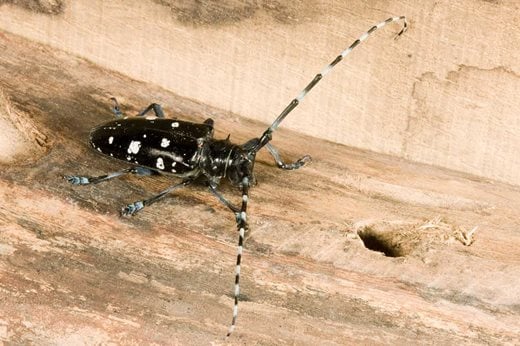 The larvae of Asian and Citrus longhorn beetles (Anoplophora glabripennis and A. chinensis) feed within trunks, branches and roots of a wide range of deciduous trees and shrubs. The tunnelling can cause substantial damage to healthy trees. Can be confused with native longhorn beetles but these are unlikely to affect healthy trees. The larvae of Asian and Citrus longhorn beetles (Anoplophora glabripennis and A. chinensis) feed within trunks, branches and roots of a wide range of deciduous trees and shrubs. The tunnelling can cause substantial damage to healthy trees. Can be confused with native longhorn beetles but these are unlikely to affect healthy trees.
Symptoms: The most obvious sign of activity are circular ‘exit’ holes around 10mm in diameter. The larvae of Citrus longhorn beetles feed on the lower trunk and roots whilst Asian longhorn beetles are found higher up the tree.
Where present: Canada, USA, China and Korea (Asian longhorn beetle); Asia and Italy (Citrus longhorn beetle). Not present in the UK; an Asian longhorn beetle colony in Kent is thought to have been eradicated.
RHS advice page
Image: Asian longhorn beetle, courtesy of Forestry Commission. |
| Processionary moths |
 Oak processionary moth (Thaumetopoea processionea) and Pine processionary moth (T. pityocampa). Oak processionary moth (Thaumetopoea processionea) and Pine processionary moth (T. pityocampa).
Oak processionary moth (OPM) and pine processionary moth (PPM) are defoliating pests of oak and pine, respectively. The caterpillars have allergy-inducing hairs that can cause breathing problems and rashes.
Symptoms: Can defoliate oak or pine trees. The caterpillars are covered in long white hairs, and move in distinctive nose to tail processions. OPM caterpillars produce white webbing nests in oak trees in early summer. PPM caterpillars produce nests in winter on pine trees.
Where present: OPM is widespread in west London plus outbreaks in Surrey and Hertfordshire; containment and eradication measures are in place. PPM is not present in the UK but is present in countries in Africa and Europe (including France, Italy and Spain).
RHS advice page on oak processionary moth
Forest Research - oak processionary moth
Forestry Commission information on pine processionary moth
|
| Red palm weevil |
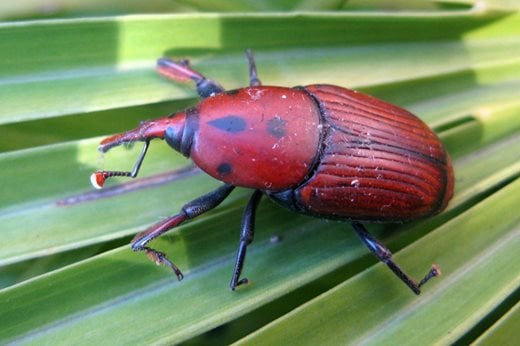 Rhynchophorus ferrugineus is an important pest of crop and ornamental palm species including coconut and date palm. Since the 1980s it has rapidly expanded its geographical range westwards. Rhynchophorus ferrugineus is an important pest of crop and ornamental palm species including coconut and date palm. Since the 1980s it has rapidly expanded its geographical range westwards.
Symptoms: Larvae and adults hollow out the interior of the palm tree, often the plant shows no sign of deterioration unless the damage is severe. The plant is then susceptible to collapse. Infestation often leads to the death of trees.
Where present: Africa, Asia, Europe (including France, Italy and Spain), Oceania and the USA. Not present in the UK.
CABI invasive species datasheet |

